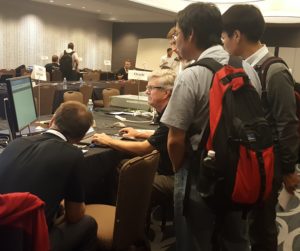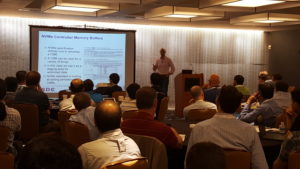Category: Object Storage
File, Block and Object Storage: Real-world Questions, Expert Answers
File vs. Block vs. Object Storage – Are Worlds Colliding?
 When it comes to storage, a byte is a byte is a byte, isn’t it?
One of the enduring truths about simplicity is that scale makes everything hard, and with that comes complexity. And when we’re not processing the data, how do we store it and access it? Read More
When it comes to storage, a byte is a byte is a byte, isn’t it?
One of the enduring truths about simplicity is that scale makes everything hard, and with that comes complexity. And when we’re not processing the data, how do we store it and access it? Read More
Expert Answers to Cloud Object Storage and Gateways Questions
How Gateways Benefit Cloud Object Storage
An FAQ to Make Your Storage System Hum
What if Programming and Networking Had a Storage Baby? Say What?
Object Drives Now Have a Management Standard
SNIA Storage Developer Conference-The Knowledge Continues
SNIA’s 18th Storage Developer Conference is officially a success, with 124 general and breakout sessions; Cloud Interoperability, Kineti c Storage, and SMB3 plugfests; ten Birds-of-a-Feather Sessions, and amazing networking among 450+ attendees. Sessions on NVMe over Fabrics won the title of most attended, but Persistent Memory, Object Storage, and Performance were right behind. Many thanks to SDC 2016 Sponsors, who engaged attendees in exciting technology discussions.
c Storage, and SMB3 plugfests; ten Birds-of-a-Feather Sessions, and amazing networking among 450+ attendees. Sessions on NVMe over Fabrics won the title of most attended, but Persistent Memory, Object Storage, and Performance were right behind. Many thanks to SDC 2016 Sponsors, who engaged attendees in exciting technology discussions.
For those not familiar with SDC, this technical industry event is designed for a variety of storage technologists at various levels from developers to architects to product managers and more. And, true to SNIA’s commitment to educating the industry on current and future disruptive technologies, SDC content is now available to all – whether you attended or not – for download and viewing.
 You’ll want to stream keynotes from Citigroup, Toshiba, DSSD, Los Alamos National Labs, Broadcom, Microsemi, and Intel – they’re available now on demand on SNIA’s YouTube channel, SNIAVideo.
You’ll want to stream keynotes from Citigroup, Toshiba, DSSD, Los Alamos National Labs, Broadcom, Microsemi, and Intel – they’re available now on demand on SNIA’s YouTube channel, SNIAVideo.
All SDC presentations are now available for download; and over the next few months, you can continue to download SDC podcasts which combine audio and slides. The first podcast from SDC 2016 – on hyperscaler (as well as all 2015 SDC Podcasts) are available here, and more will be available in the coming weeks.
SNIA thanks all its members and colleagues who contributed to make SDC a success! A special thanks goes out to the SNIA Technical Council, a select group of acknowledged industry experts who work to guide SNIA technical efforts. In addition to driving the agenda and content for SDC, the Technical Council oversees and manages SNIA Technical Work Groups, reviews architectures submitted by Work Groups, and is the SNIA’s technical liaison to standards organizations. Learn more about these visionary leaders at http://www.snia.org/about/organization/tech_council.
And finally, don’t forget to mark your calendars now for SDC 2017 – September 11-14, 2017, again at the Hyatt Regency Santa Clara. Watch for the Call for Presentations to open in February 2017.
Clustered File Systems: No Limits
Today’s storage world would appear to have been divided into three major and mutually exclusive categories: block, file and object storage. The marketing that shapes much of the user demand would appear to suggest that these are three quite distinct animals, and many systems are sold as exclusively either SAN for block, NAS for file or object. And object is often conflated with cloud, a consumption model that can in reality be block, file or object.
A fixed taxonomy that divides the storage world this way is very limiting, and can be confusing; for instance, when we talk about cloud. How should providers and users buy and consume their storage? Are there other classifications that might help in providing storage solutions to meet specific or more general application needs? What about customers who need file access performance beyond what one storage box can provide? Which options support those who want scale-out solution like object storage with file protocol semantics?
To clear up the confusion, the SNIA Ethernet Storage Forum is hosting a live Webcast, “Clustered File Systems: No Limits.” In this Webcast we will explore clustered storage solutions that not only provide multiple end users access to shared storage over a network, but allow the storage itself to be distributed and managed over multiple discrete storage systems. You’ll hear:
- General principles and specific clustered and distributed systems and the facilities they provide built on the underlying storage
- Better known file systems like NFS, IBM Spectrum Scale (GPFS) and Lustre, along with a few of the less well known
- How object based systems like S3 have blurred the lines between them and traditional file based solutions
This Webcast should appeal to those interested in exploring some of the different ways of accessing & managing storage, and how that might affect how storage systems are provisioned and consumed. POSIX and other acronyms may be mentioned, but no rocket science beyond a general understanding of the principles of storage will be assumed. Contains no nuts and is suitable for vegans!
As always, our experts will be on hand to answer your questions on the spot. Register now for this October 25th event.